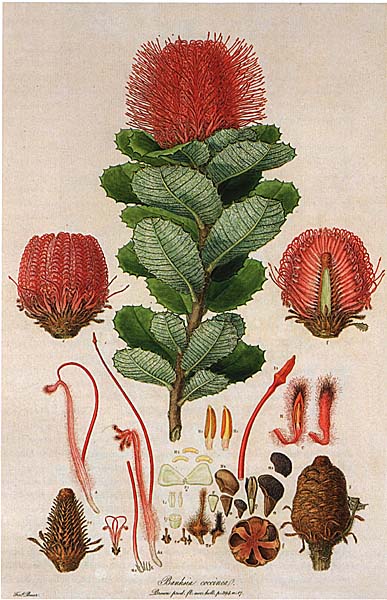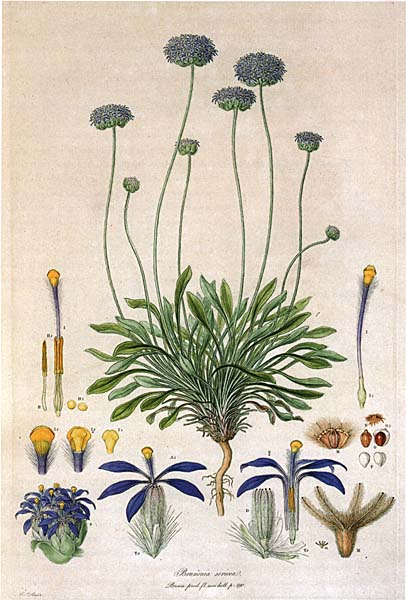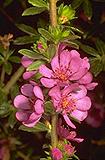|
[Front Page] [Features] [Departments] [Society Home] [Subscribe]

In Honour of Ferdinand Bauer
Florence Dwight
Ferdinand Bauer. after whom the genus Bauera was named, was born in 1760 into an age of great geographical and botanical exploration. He was to become pre-eminent among botanical illustrators of every age.
When 15 years old Ferdinand and two older brothers, having lost their father as infants, were employed by the prior of their home-town monastery in Feldsperg, Austria. With twin interests in medicine and botany, the prior set the boys recording, in miniature, the fine collection of plants in the monastery garden. Thus the brothers' natural artistic talents were channelled into plant illustration. Their work, of 2750 miniatures, is now held by the Liechtenstein Gallery in Vaduz.
Five years later Franz and Ferdinand Bauer moved to Vienna to work in the University botanic garden. Here, working on illustrations for the Professor of Botany's book of rare plants, they were introduced to microscopic work which expanded their remarkable talent for accurate observation of minute detail. Botanists of the time seemed to have formed a close knit international fraternity, corresponding with each other, exchanging specimens and giving helpful information-such as where a skilled illustrator could be found. Thus it was that the Professor Sibthorpe, Professor of Botany at Oxford University. engaged Ferdinand Bauer as Natural History Painter on his field trip to Greece. During this trip Bauer expanded his study of botany as a science. When Sibthorpe returned to England in 1787 Bauer went with him to prepare his more-than-1500 drawings for publication. These were eventually published in the Flora Graeca, considered by some experts to be the most beautiful botanical work ever produced.

Banksia coccinea
Australian National Botanic Gardens
|
|
A few years later Ferdinand was joined in England by Franz who had accepted Sir Joseph Banks' invitation to take up a position as botanical artist at Kew Gardens. Franz remained there for fifty years. Ferdinand himself was chosen by Banks for a more adventurous position. Banks had persuaded Earl Spencer, First Lord of the Admiralty, to authorise a voyage under the command of Matthew Flinders to complete the survey of the coast of New Holland and to study the fauna and flora. Ferdinand was appointed botanic draftsman to work under the direction of expedition naturalist, Robert Brown, a Scottish medical practitioner and outstanding botanist. Instructions from the Admiralty to Flinders included giving the naturalists and artists sufficient time on land to do their work, and the construction of a plant cabin so that living plants might be brought back to Kew Gardens.
H.M. Sloop Investigator was refitted according to Banks' specifications. The scientists were well equipped for their work, having on board a collection of Australian specimens, a greenhouse, a microscope and a huge library of books on South Sea voyages, including Banks' own copy of the Endeavour Journal which he had written on Cook's voyage.
|
Bauer, aged 40, was nearly twice as old as the other gentlemen on board (including the captain) but proved a better sailor than some of his shipmates, coping very well with the hardships and dangers of the epic voyage. Constantly leaking, Investigator proved a poor choice of vessel. and dampness and mould caused problems throughout the voyage.
The expedition set sail on 18 July, 1801. with a crew of 88. Cape Leeuwin was sighted on 6 December and named by Flinders in honour of the Dutch ship, which had first called there in 1622. On 28 January, 1802, the ship sailed into the Great Australian Bight-named later by Flinders using the word 'Australia' as part of a place name for the first time.
On 8 April the British expedition had an historic meeting with their French rivals on the ship Le Geographe commanded by Captain Baudin. Encounter Bay was named to commemorate this occasion.
On this section of the trip, plants collected included some in south west Australia, the first collected of South Australia's flora and the first recorded collection of Victorian flora.

Brunonia australis
Australian National Botanic Gardens
|
|
Port Jackson was entered on 9 May 1802 and the Investigator anchored in Sydney Cove after a journey of 295 days. The scientists made the most of their six-week stay in Sydney to explore and collect. Bauer's sketches. now numbering 700, were left with Governor King for safekeeping. Letters to Banks from both Flinders and Brown praise Bauer highly. Brown describing him as "indefatigable".
On 2 July Investigator, accompanied by the Lady Nelson for in-shore work, set sail up the East Coast. The naturalists continued collecting and recording while Flinders carried out surveying from the deck of the Lady Ne/son. Three months were spent in the Gulf of Carpentaria surveying the coast.
Soon afterwards the painstaking surveying and collecting came to an end. Because of the poor condition of the ship, the poor health of the crew and his desire to avoid having to sail along the dangerous southern coast in winter, Flinders decided to finish the circumnavigation of the continent as quickly as possible.
|
The expedition arrived back at Port Jackson on 9 June 1803. Bauer had made sketches of 500 species of plants and 90 animals (mostly birds). He had not been able to complete any paintings because his paper had become covered with spots of mould, The Investigator was examined and condemned as unseaworthy.
While Flinders made arrangements to return to England to obtain another ship in order to complete the survey of the north and west coasts, Brown and Bauer decided to remain in Australia and wait for Flinders' return, This was not to eventuate. Flinders fell victim to renewed hostilities between England and France and languished in prison on Mauritius for six and a half years.
Brown and Bauer shared a house in Sydney for several months until Brown decided to go to Van Diemens Land on the Lady Nelson while Bauer chose to stay in Sydney. In August 1804, when the opportunity arose, Bauer sailed to Norfolk Island where he spent eight months collecting and sketching from the day he arrived. Returning to Sydney on 3 March, 1805 he was reunited with Brown. They continued working right up to their departure on 23 May on the patched-up Investigator. The voyage home, of almost five months, was uncomfortable but uneventful. Each of them returned with large collections and Bauer had over 2,000 sketches, all including drawings of minute dissections of the specimens.
 |
 |
|
Two of the three members of the genus Bauera:
Bauera sessiliflora (left) is found only in western Victoria while the better known Bauera rubioides, the dog rose or river rose (right) is widespread in all the eastern states.
Select the thumbnail image or plant names for higher resolution images (33k and 23k).
|
Sir Joseph persuaded the Admiralty to retain the services of Brown and Bauer while they completed their work. Bauer produced around 300 magnificent watercolours of his Australian sketches. His astonishing accuracy in colouring was achieved through a complex colour code he had devised early in his career. numbering from 1 to 999. All his sketches were covered in numbers later "translated into gradations of colour so fine that recapturing each shade seems more a job for a computer than a man" (review in the Sydney Morning Herald, 17 Jan. 1998).
He and Brown were still working on the Australian collection when Flinders eventually arrived back in London in 1810 and was reunited with his wife, and Brown and Bauer. Flinders spent the next four years preparing his monumental work, A Voyage to Terra Australis. The three volumes were published the day before he died. Brown published the first volume of his Prodromus Florae Novae Hollandiae et Insulae Van Diemen in 1810. The planned second volume was never published. Bauer worked on his Illustrationes Florae novae Hollandiae for six years doing all the engraving and colouring himself to obtain the high standard which alone satisfied him. Only three parts of what was intended to be a much larger work to illustrate Brown's Prodomus were published, in less than fifty copies, containing fifteen exquisite large folio plates.
They were a financial failure, as were Flinders' and Brown's publications and Banks' own Florilegium. The period of the Napoleonic Wars was not a favourable time for the launching of expensive botanical publications. Bauer returned to Austria in 1814 where he lived comfortably, continuing his work until his death in 1826, aged 66. Bauer's collection is today divided between the British Museum (Natural History) and the Natural History Museum in Vienna. Most of the watercolours are in London and most of the drawings in Vienna. Some of his paintings and drawings were exhibited in Australia during 1998. The exhibition was titled 'An Exquisite Eye. The Australian Flora and Fauna Drawings, 1801-1820, of Ferdinand Bauer',
References
- Norst, Marlene 1989, Ferdinand Bauer, the Australian natural history drawings, Lothian Publishing Co. Melbourne.
- A Fine feld for botanising, Catalogue for exhibition in association with the Xlil International Botanical Congress, Sydney, 21-28 August 1981.
- Stearn, W. T. 1981, Ferdinand Lucas Bauer (1760-1826 - butanical artist extraordinaire in Australia 1801-1805, Lecture delivered at the XlIl International Botanical Congress.
- An Exquisite Eye Sydney Morning Herald, January 17 1998.
From the June 1998 issue of Eucryphia, newsletter of the Australian Plants Society (Tasmania)

[Front Page] [Features] [Departments] [Society Home] [Subscribe]
Australian Plants online - March 2001
Association of Societies for Growing Australian Plants
|